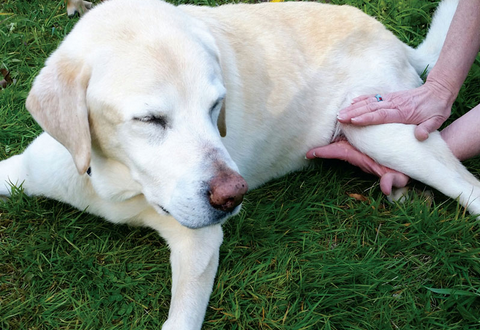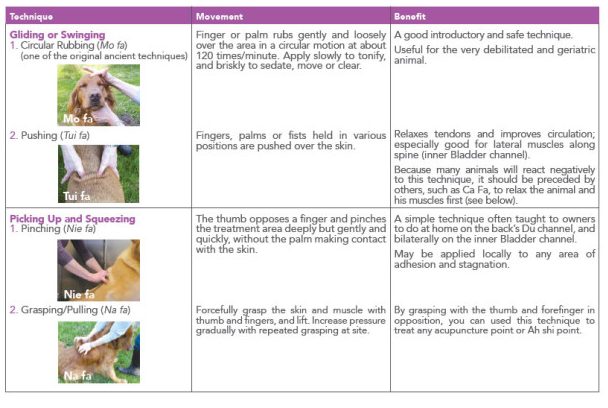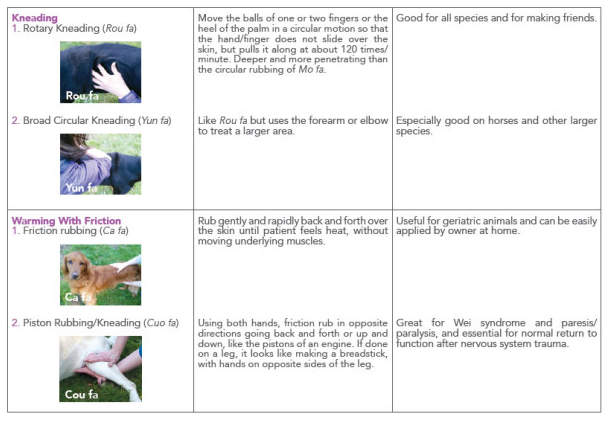Tui-Na: Chinese Medical Massage
by Michelle C. Schraeder, DVM, MEd, FAAVA - Featured in IVC Journal ~ Summer 2015
|
The earliest documentation of Traditional Chinese Medicine (TCM), written about 2,500 years ago, includes among its five branches Tui-na or Chinese medical massage. Tui-na (pronounced twee-nah) utilizes massage manipulations that stimulate acupressure points or surface regions of the body to:
• restore physiological balance by re-establishing flow to the channels and collaterals • promote blood circulation • regulate Yin and Yang All branches of TCM view the body as an integrated whole (this, holistic medicine), and the theories of Yin and Yang, five element, and meridian/channel all embrace this basic concept. By restoring balance, Tui-na supports the body’s natural functions to combat excess or deficient conditions as needed. It helps keep Qi and blood moving freely, strengthens tendons, ligaments and muscles, promotes normal function, and eliminates fatigue. |
HISTORY OF TUI-NA AND OTHER ORIENTAL MASSAGE TECHNIQUESWhile Tui-na originated in China, it spread via trade missions to other countries like Japan and Korea during the sixth century, and became the basis for the myriad of Oriental bodywork styles that exist today, including Shiatsu, Thai, and Indonesian massage. Like Tui-na, all these forms consider the body from a holistic perspective, as a whole.
Swedish and other Western types of massage, on the other hand, are based more on treating a particular symptom or injury. However, Western massage texts do refer to methods that have similarities to various Tui-na techniques. Goats1 reviewed previous research on the mechanism of action for different Tui-na techniques:
• Effleurage – to slide or glide over skin with smooth stroking hand movements, frequently at the beginning and end of a treatment session. With effleurage techniques, gradual compression reduces muscle tone and induces a general state of relaxation that relieves muscle spasm and prepares the patient for more vigorous treatment. Firm pressure accelerates blood and lymph flow, improves tissue drainage and thus reduces recent swelling. Rapid strokes have the opposite effect and will increase muscle tone, which can be useful for competition.
• Petrissage – to lift, wring, or squeeze soft tissues in a kneading motion, or to roll tissues. Petrissage is particularly useful for stretching contracted or adherent fibrous tissue, and will relieve muscle spasm. It also promotes the flow of body fluids and can resolve long-standing swelling. Kneading promotes the flow of tissue fluid and causes reflex vasodilation and marked hyperemia, thus reducing swelling and inflammation. Vigorous kneading decreases muscle spasms and can stretch tissues shortened by injury.
• Friction – to rub superficially to create heat, or deeper to stop tissue adhesions. The localized stretching and degradation of collagen caused by friction techniques can restore fibers to a more normal alignment during the remodeling phase of healing.
• Tapotement – to perform percussive massage techniques that trigger cutaneous reflexes and cause vasodilation.
Much research has been done, mostly in humans, on the various types of massage. One “high-quality study” that compared acupuncture massage (Tui-na) with classic Swedish massage showed that acupuncture massage was superior (irrespective of the type of exercise received) on measures of both pain and function.2 The claim that Tui-na influences health through organ effects may be explained by the activation of autonomic nervous system effects on the organs via stimulation of the afferent pathways and the subsequent efferent influence on tissues and organs.
Swedish and other Western types of massage, on the other hand, are based more on treating a particular symptom or injury. However, Western massage texts do refer to methods that have similarities to various Tui-na techniques. Goats1 reviewed previous research on the mechanism of action for different Tui-na techniques:
• Effleurage – to slide or glide over skin with smooth stroking hand movements, frequently at the beginning and end of a treatment session. With effleurage techniques, gradual compression reduces muscle tone and induces a general state of relaxation that relieves muscle spasm and prepares the patient for more vigorous treatment. Firm pressure accelerates blood and lymph flow, improves tissue drainage and thus reduces recent swelling. Rapid strokes have the opposite effect and will increase muscle tone, which can be useful for competition.
• Petrissage – to lift, wring, or squeeze soft tissues in a kneading motion, or to roll tissues. Petrissage is particularly useful for stretching contracted or adherent fibrous tissue, and will relieve muscle spasm. It also promotes the flow of body fluids and can resolve long-standing swelling. Kneading promotes the flow of tissue fluid and causes reflex vasodilation and marked hyperemia, thus reducing swelling and inflammation. Vigorous kneading decreases muscle spasms and can stretch tissues shortened by injury.
• Friction – to rub superficially to create heat, or deeper to stop tissue adhesions. The localized stretching and degradation of collagen caused by friction techniques can restore fibers to a more normal alignment during the remodeling phase of healing.
• Tapotement – to perform percussive massage techniques that trigger cutaneous reflexes and cause vasodilation.
Much research has been done, mostly in humans, on the various types of massage. One “high-quality study” that compared acupuncture massage (Tui-na) with classic Swedish massage showed that acupuncture massage was superior (irrespective of the type of exercise received) on measures of both pain and function.2 The claim that Tui-na influences health through organ effects may be explained by the activation of autonomic nervous system effects on the organs via stimulation of the afferent pathways and the subsequent efferent influence on tissues and organs.
TUI-NA IN PRACTICELet’s look at a specific example of how Tui-na might work in practice. Back pain is a common problem whether you are a human or animal. The Western or conventional approach would be to prescribe anti-inflammatories, rest, and possibly surgery. Back pain comes with tension in the back muscles and eventual weakening of the legs. Tui-na and other massages can help manage chronic pain by relieving it directly through muscle relaxation, and indirectly through stress-reducing mechanisms. These include the enhancement of parasympathetic nervous activity, and the activation of inhibitory mechanisms that suppress pain, increase relaxation, and improve sleep.3
As a potent mechanical stimulus, massage is a particularly effective trigger for short-lived analgesia from the “pain gate” mechanism.1 Longer-lasting pain control, which happens via the “descending pain suppression mechanism” and results in endorphins being released from the brain during massage, brings about both mental and muscular relaxation. Increased heat and local circulation from vasodilation help to further reduce pain and speed healing. The subsequent outcome is a feeling of vitality and well-being.
How Tui-na affects Qi
In Chinese medicine, Qi is collectively referred to as the vital energies of the body. Qi and Blood stagnation (lack of movement) can result in pain, stiffness, emotional stress, anger, frustration, depression, various organ diseases, and masses. Through many types of body manipulation, Tui-na seeks to move Qi and/or Blood to relieve pain. Since excess emotions and life stresses can also affect Qi flow, one can achieve emotional and physical balance and provide rest and relaxation for the patient by restoring the free flow of Qi.
As a potent mechanical stimulus, massage is a particularly effective trigger for short-lived analgesia from the “pain gate” mechanism.1 Longer-lasting pain control, which happens via the “descending pain suppression mechanism” and results in endorphins being released from the brain during massage, brings about both mental and muscular relaxation. Increased heat and local circulation from vasodilation help to further reduce pain and speed healing. The subsequent outcome is a feeling of vitality and well-being.
How Tui-na affects Qi
In Chinese medicine, Qi is collectively referred to as the vital energies of the body. Qi and Blood stagnation (lack of movement) can result in pain, stiffness, emotional stress, anger, frustration, depression, various organ diseases, and masses. Through many types of body manipulation, Tui-na seeks to move Qi and/or Blood to relieve pain. Since excess emotions and life stresses can also affect Qi flow, one can achieve emotional and physical balance and provide rest and relaxation for the patient by restoring the free flow of Qi.
Contraindications
It’s inadvisable to perform Tui-na:
• Directly on inflamed or broken skin
• On brittle bones
• During pregnancy on lower back or abdomen, and on certain acupuncture points contraindicated in pregnancy
• At acute fracture sites
• On very old and very weak patients.5,6
It’s inadvisable to perform Tui-na:
• Directly on inflamed or broken skin
• On brittle bones
• During pregnancy on lower back or abdomen, and on certain acupuncture points contraindicated in pregnancy
• At acute fracture sites
• On very old and very weak patients.5,6
INDIVIDUAL TECHNIQUESTui-na techniques focus on specific painful sites, acupressure points, meridians, and muscles and joints. Each of these techniques has aspects of quantity (duration and force) and quality (evenness and softness). For equipment, all you need are your fingers, hands, elbows and knees. The sampling of techniques in this article is grouped by type of motion.4,5
Many of the movements are not difficult, so we can empower clients to become part of the healing process – something every caring animal owner desires. Often, I briefly demonstrate these techniques on owners so they better understand them.
CONCLUSIONTui-na is useful for muscle and joint pain from injury or chronic wear and tear, as well as stress-related disorders. It can also be used to support other treatment modalities. Performance animals, chronically ill and geriatric patients can all greatly benefit from regular Tui-na from their owners or veterinarians. For further training, a veterinary Tui-na course is available through the Chi Institute in Reddick, Florida.
1 Goats GC. “Massage-the Scientific Basis of an Ancient Art”. BR J Sports Med. 1994; 28: 149-156.2 Furlan AD, Brosseau L, Imamura M, Irvin E. “Massage for Low-Back Pain: A Systematic Review within the Framework of the Cochrane Collaboration Back Review Group”. Spine. 2002; 27(17):1896-1910.
3 Hart J. “Complementary Therapies for Chronic Pain Management”. Alternative & Complementary Therapies. April 2008; 64-68.
4 Ping, Chen (ed). Chinese Tuina and Therapeutic Applications: Advanced TCM Series, Volume 7. Beijing: Science Press, 1998: 72-91.
5 Chi Institute. Application of Tui-Na in Veterinary Practice. Proceedings of 5th Advanced TCVM Seminar, 2003: 135, 147- 149.
6 Mercati, Maria. The Handbook of Chinese Massage: Tui Na Techniques to Awaken Body and Mind. Rochester, VT: Healing Arts Press, 1997:11-12.
Many of the movements are not difficult, so we can empower clients to become part of the healing process – something every caring animal owner desires. Often, I briefly demonstrate these techniques on owners so they better understand them.
CONCLUSIONTui-na is useful for muscle and joint pain from injury or chronic wear and tear, as well as stress-related disorders. It can also be used to support other treatment modalities. Performance animals, chronically ill and geriatric patients can all greatly benefit from regular Tui-na from their owners or veterinarians. For further training, a veterinary Tui-na course is available through the Chi Institute in Reddick, Florida.
1 Goats GC. “Massage-the Scientific Basis of an Ancient Art”. BR J Sports Med. 1994; 28: 149-156.2 Furlan AD, Brosseau L, Imamura M, Irvin E. “Massage for Low-Back Pain: A Systematic Review within the Framework of the Cochrane Collaboration Back Review Group”. Spine. 2002; 27(17):1896-1910.
3 Hart J. “Complementary Therapies for Chronic Pain Management”. Alternative & Complementary Therapies. April 2008; 64-68.
4 Ping, Chen (ed). Chinese Tuina and Therapeutic Applications: Advanced TCM Series, Volume 7. Beijing: Science Press, 1998: 72-91.
5 Chi Institute. Application of Tui-Na in Veterinary Practice. Proceedings of 5th Advanced TCVM Seminar, 2003: 135, 147- 149.
6 Mercati, Maria. The Handbook of Chinese Massage: Tui Na Techniques to Awaken Body and Mind. Rochester, VT: Healing Arts Press, 1997:11-12.



